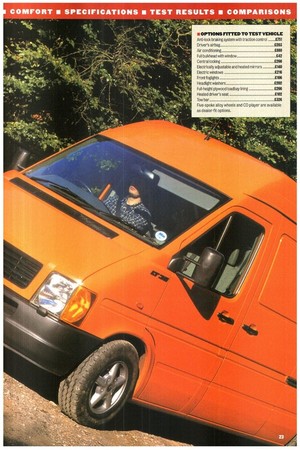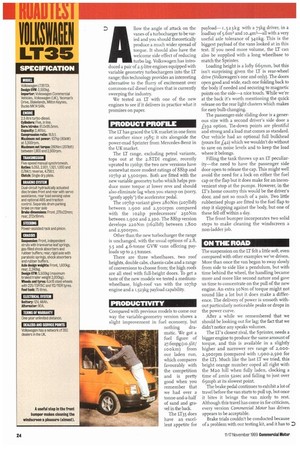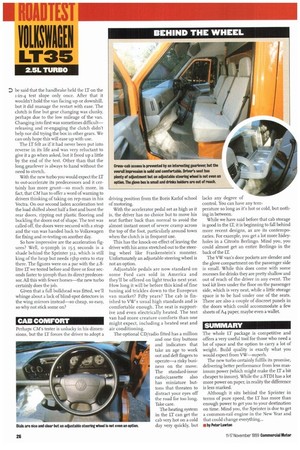VOLKSWAGEN LT35
Page 24

Page 25

Page 26

Page 28

If you've noticed an error in this article please click here to report it so we can fix it.
'PRICE AS TESTED: £23,438 (ex-VAT), including £19,980 for basic vehicle (see panel for options fitted to test vehicle). ENGINE: 2.5-litre direct injection turbo-diesel with variable geometry. GYM 3,500 k. PAYLOAD: 1,523kg (including 75kg driver). FUEL CONSUMPTION (laden): 27.6mpg (10.31it/100km).
Volkswagen has the 2.8-litre monster LT to take on the speed of Mercedes' 312 Sprinter. But now it's fitted a variable-geometry turbocharger to two smaller versions in an effort to give the LT smooth power delivery from low down in the rev range. Does this clever blower make for a practical van, or is Volkswagen just tilting at windmills?
• OPTIONS rrrrED TO TEST VEHICLE
Anti-lock braking system with traction control £751 Driver's airbag £203 Air conditioning 1888 Full bulkhead with window 142 Central locking £266 Electrically adjustable and heated mirrors £140 Electric windows £216 Front foglights £106 Headlight washers £202 Full-height plywood oadbay lining £266 Heated driver's seat £102 Tow bar £326 Five-spoke alloy wheels and CD player are available as dealer-fit options.
IOLKSWAGEN
LT35
SPECIFICATION
MODEL Volkswagen LT35TDI.
Design 3,500kg.
Importer: Volkswagen Commercial Vehicles, Volkswagen (UK), Yeoman's Drive, Blakelands, Milton Keynes, Bucks MK14 SAN.
ENGINE 2.5 litre turbo-diesel.
Cylinders: Five, in line.
Bore /stroke: 81.0 x95.5mm.
Capacity: 2,461cc.
Compression ratio: 19.5:1.
Maximum net Dower: 107hp (80kW) at 3,500rpm.
Maximum net torque: 280Nm (2071bft) between 1,900 and 2,500rpm.
TRANSMISSION Five-speed manual synchromesh. Raw 5.053, 2.601,1.521, 1.000 and 0.784:1; reverse, 4.756:1.
Clutch: Single dry plate.
BRAKING SYSTEM Dual-circuit hydraulically actuated disc brakes front and rear with servo assistance, rear load sensing valve and optional ABS and traction control. Separate drum parking brake on rear axle Drab dimensions: Front ,276x22mm; rear, 272x16mm.
STEERMG Power-assisted rack and pinion.
CHASSIS Suspension: Front, independent struts with transverse leaf springs, gas-filled shock absorbers and rubber buffers; rear, rigid axle with parabolic springs, shock absorbers and rubber buffers.
Axle design weight= Front, 1,600kg; rear, 2,240kg.
Design (fft 5,500kg (maximum braked trailer weight 2,000kg). Wheels and tyres: 6Jx15 steel wheels with 225/70R15C and 12/110R tyres. Fool tank:75 litres.
ELECTRICAL SYSTEM Battery :12V, 88A11. Alternator 90A.
TERMS OF WARRANTY One-year unlimited distance.
DEALERS AND SERVICE POINTS Volkswagen has a network of 350 dealers in the UK.
Dhow the angle of attack on the
vanes of a turbocharger to be varied and you should theoretically produce a much wider spread of torque. It should also have the welcome side effect of reducing turbo lag. Volkswagen has intro
duced a pair of 2.5-litre engines equipped with variable geometry turbochargers into the LT range; this technology provides an interesting alternative to the flurry of excitement over common-rail diesel engines that is currently sweeping the industry.
We tested an LT with one of the new engines to see if it delivers in practice what it promises on paper.
PRODUCT PROFILE
The LT has graced the UK market in one form or another since 1985; it sits alongside the power-mad Sprinter from Mercedes-Benz in the UK market.
The LT range, excluding petrol variants, tops out at the 2.8TDI engine, recently uprated to i3ohp; the two new versions have somewhat more modest ratings of 88hp and ro7hp at 3,5oorpm. Both are fitted with the new variable geometry turbo which helps produce more torque at lower revs and should also eliminate lag when you stamp on (sorry, "gently apply") the accelerator pedal.
The Io7hp variant gives 28oNm (2o7lbft) between 1,900 and 2,500rpm compared with the ro2hp predecessors' 2.50Nm between 1,900 and 2,300. The 88hp version develops 22 0 N m ( 621bft) between r, 8 oo and 2,500rpm.
Other than the new turbocharger the range is unchanged, with the usual options of 2.8, 3.5 and 4.6-tonne GVW vans offering payloads up to 2.5 tonnes.
There are three wheelbases, two roof heights, double cabs, chassis-cabs and a range of conversions to choose from; the high roofs are all steel with full-height doors. To get a taste of the new models we tested a mediumwheelbase, high-roof van with the ro7hp engine and a 1,523kg payload capability.
PRODUCTIVITY
Compared with previous models to come our way the variable-geometry version shows a slight improvement in fuel economy, but
nothing dramatic. We got a fuel figure of 27.6mpg (to.31iti rookm) from our laden run, which compares favourably with the competition and is pretty good when you remember that we had over a tonne-and-a-half of sand and gravel in the back
The LT35 does have an excellent appetite for
payload-1,5 2 3 kg with a 75kg driver, in a loadbay of 5.6m2 and 10.4m3—all with a very useful axle tolerance of 340kg. This is the biggest payload of the vans looked at in this test. If you need more volume, the LT can also be supplied with a long wheelbase to match the Sprinter.
Loading height is a lofty 665 mm, but this isn't surprising given the LT is rear-wheel drive (Volkswagen's one and only). The doors open good and wide, each one folding back to the body if needed and securing to magnetic points on the side—a nice touch. While we're at the back it's worth mentioning the quick release on the rear light clusters which makes for easy bulb changing.
The passenger-side sliding door is a generous size with a second driver's side door a 1392 option. Tie-down points are plentiful and strong and a load mat comes as standard. Our vehicle had an optional full bulkhead (yours for £42) which we wouldn't do without to save on noise levels and to keep the load where it belongs.
Filling the tank throws up an LT peculiar. ity—the need to have the passenger side door open to release the cap. This might well avoid the need for a lock on either the fuel cap or the flap but it does make for an inconvenient stop at the pumps. However, in the LT's home country this would be the driver's door, and not so much of a pain. Two little rubberised plugs are fitted to the fuel flap to stop it slapping against the body, but one of these fell off within a day.
The front bumper incorporates two solid steps to make cleaning the windscreen a non-ladder job.
ON THE ROAD
The suspension on the LT felt a little soft, even compared with other examples we've driven. More than once the van began to sway slowly from side to side like a pendulum, but with time behind the wheel, the handling became more and more like second nature and gave us time to concentrate on the pull of the new engine. An extra 3o Nm of torque might not sound like a lot but it does make a difference. The delivery of power is smooth without particularly noticeable peaks or drops in the power curve.
After a while we remembered that we should be looking out for lag; the fact that we didn't notice any speaks volumes.
The LT's closest rival, the Sprinter, needs a bigger engine to produce the same amount of torque, and this is available in a slightly higher and narrower rev range of 2,0002,3oorpm (compared with 1,900-2,500 for the LT). Much like the last LT we tried, this bright orange number coped all right with the Mao hill when fully laden, clocking a time of 2min 52sec and falling to just over 65mph at its slowest point.
The brake pedal continues to exhibit a lot of travel before the van starts to pull up, but once it bites it brings the van nicely to rest. Although this travel has come in for criticism, every version Commercial Motor has driven appears to be acceptable.
Brake trials couldn't be conducted because of a problem with our testing kit, and it has to D 0 be said that the handbrake held the LT on the 1-in-4 test slope only once. After that it wouldn't hold the van facing up or downhill, but it did manage the restart with ease. The clutch is fine but gear changing was dunky, perhaps due to the low mileage of the van. Changing into first was sometimes difficult— releasing and re-engaging the clutch didn't help nor did hying the box in other gears. We can only hope this will ease up with use.
The LT felt as if it had never been put into reverse in its life and was very reluctant to give it a go when asked, but it freed up a little by the end of the test. Other than that the long gearlever is always to hand without the need to stretch.
With the new turbo you would expect the LT to out-accelerate its predecessors and it certainly has more grunt—so much more, in fact, that CM has to offer a word of warning to drivers thinking of taking on rep-man in his Vectra. On our second laden acceleration test the load shifted about half a foot and burst the rear doors, ripping out plastic flooring and buckling the doors out of shape. The test was called off, the doors were secured with a strap and the van was handed back to Volkswagen for fixing and re-testing on another day.
So how impressive are the acceleration figures? Well, 43-50mph in 15.5 seconds is a shade behind the Sprinter 312, which is still king of the heap but needs r5hp extra to stay there. The figures were on a par with the 2.8litre IT we tested before and three or four seconds faster to 50mph than its direct predecessor. All this with fewer horses—the new turbo certainly does the job.
Given that a full bulkhead was fitted, we'll whinge about a lack of blind-spot detectors in the wing mirrors instead—so cheap, so easy, so why not stick some on?
CAB COMFORT
Perhaps CM's tester is unlucky in his dimensions, but the LT forces the driver to adopt a
driving position from the Boris Karlof school of motoring.
With the accelerator pedal set as high as it is, the driver has no choice but to move his seat further back than normal to avoid the almost instant onset of severe cramp across the top of the foot, particularly around town when the clutch is in frequent use.
This has the knock-on effect of leaving the driver with his arms stretched out to the steering wheel like Frankenstein's monster. Unfortunately an adjustable steering wheel is not an option.
Adjustable pedals are now standard on some Ford cars sold in America and they'll be offered on light trucks next year. How long it will be before this kind of fine tuning aid trickles down to the European van market? Fifty years? The cab is finished to VW's usual high standards and is comfortable enough. The seat is supportive and even electrically heated. The test van had more creature comforts than one might expect, including a heated seat and air conditioning.
The optional CD/radio fitted has a million and one tiny buttons and indicators that take an age to work out and deft fingers to operate—a risky business on the move. The standard-issue radio/cassette also has miniature buttons that threaten to distract your eyes off the road for too long. Take care.
The heating system in the LT can get the cab very hot on a cold day very quickly, but lacks any degree of
control. You can have any tem perature so long as it's hot or cold, but nothing in between.
While we have said before that cab storage is good in the LT, it is beginning to fall behind more recent designs, as are its contemporaries. For example, you get a lot more hideyholes in a Citron Berlingo. Mind you, you could almost get an entire Berlingo in the back of the IT.
The VW vans door pockets are slender and the glove compartment on the passenger side is small. While this does come with some recesses for drinks they are pretty shallow and out of reach of the driver in any event. The tool kit lives under the floor on the passenger side, which is very neat, while a little storage space is to be had under one of the seats. There are also a couple of discreet panels in the doors which could accommodate a few sheets of A4 paper, maybe even a wallet.
SUMMARY
The whole LT package is competitive and offers a very useful tool for those who need a lot of space and the option to carry a lot of weight. Build quality is exactly what you would expect from VW—superb.
The new turbo certainly fulfils its promise, delivering better performance from less maximum power (which might make the LT a bit cheaper to insure). While the 2.8TDI has a lot more power on paper, in reality the difference is less marked.
Although it sits behind the Sprinter in terms of pure speed, the LT has more than enough power to get you to your destination on time. Mind you, the Sprinter is due to get a common-rail engine in the New Year and that could change everything...
• by Peter Lawton












































































































